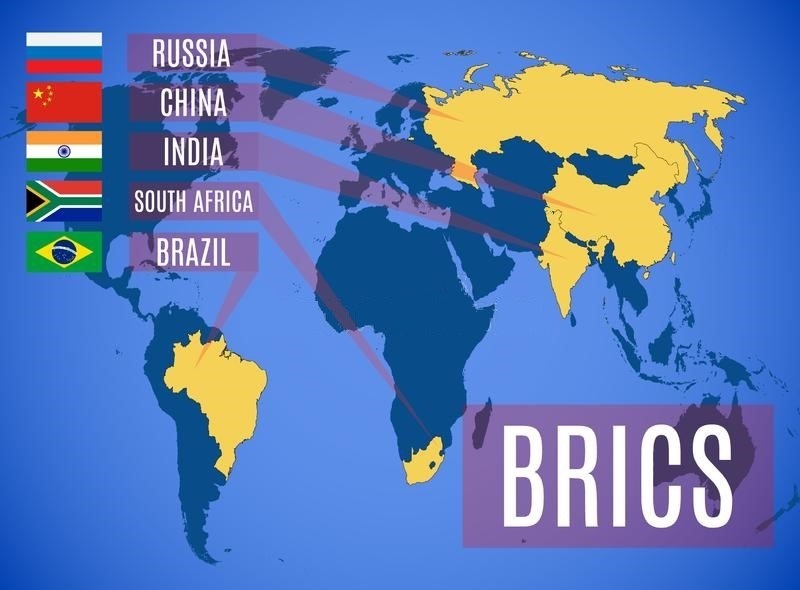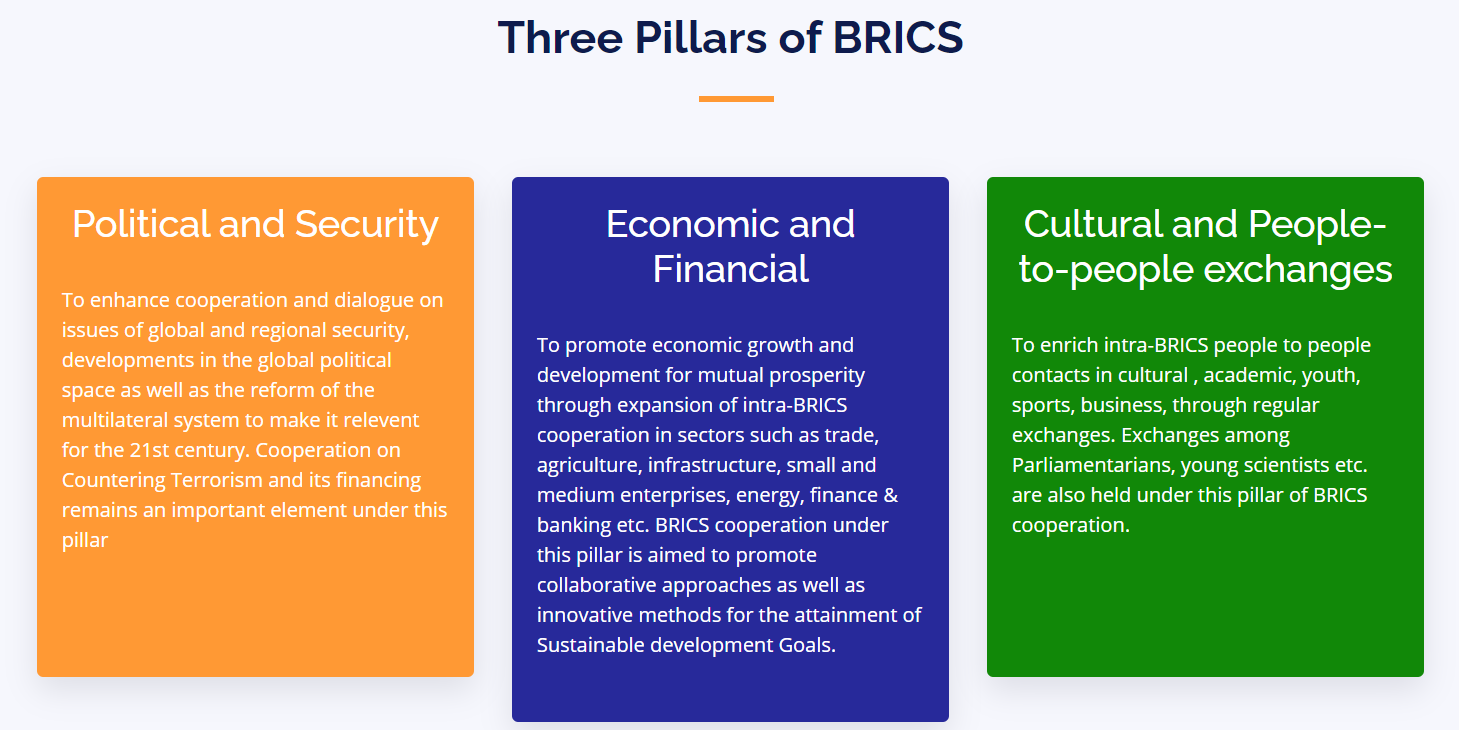BRICS GROUP
2021 SEP 1
Mains >
International relations > India and Global Powers > International groupings

IN NEWS:
- The 13th BRICS summit is set to be held on September 9 in digital format under India’s chairmanship.
WHAT IS BRICS:
- BRICS is an acronym for the informal grouping of the world’s leading emerging economies, namely Brazil, Russia, India, China and South Africa.
- The BRICS mechanism aims to promote peace, security, development and cooperation towards establishing a fair and equitable world.
- BRICS accounts for 41% of the world’s population, 30% of the land area, 24% of global GDP and 16% of international trade.
- It has its headquarters at the BRICS tower in Shanghai, China.

HISTORY:
- The leaders of BRIC (Brazil, Russia, India, and China) countries met for the first time in Russia, on the margins of G8 Outreach Summit in July 2006. Shortly afterwards, in September 2006, the group was formalised as BRIC.
- After a series of high-level meetings, the 1st BRIC summit was held in Yekaterinburg, Russia on 16 June 2009.
- The group was renamed as BRICS after South Africa was accepted as a full member in September 2010.
WORKING:
- Relations between BRICS partners are built on the UN Charter, generally recognised principles & norms of international law and the principles of openness, pragmatism, solidarity, non-bloc nature and neutrality with regard to third parties.
- The system of cooperation formats between BRICS countries includes:
- Annual scheduled summits, which are chaired by turn. India held the chair in 2012 and 2016 too.
- Leaders’ meetings on the sidelines of the UN General Assembly, G20 summits etc.
- Meetings between high representatives like foreign ministers, ministers of finance and governors of central banks.
- BRICS sherpas and sous-sherpas.
-
- Meetings of working cooperation groups for agriculture and agrarian development, healthcare, information security, science and innovation.
- Meetings of chairpersons of Supreme Courts, heads of central election commissions, and representatives of municipal administrations and partner regions.
- Apart from joint events involving executive agencies and the judiciary branch, business organisations and research centres cooperate within the BRICS format.
|
INDIA’S PRIORITIES FOR THE 13TH SUMMIT:
As the current chair, India has outlined four priorities for the upcoming summit:
- Pursue reform of multilateral institutions like the United Nations, World Bank, IMF, WTO and WHO.
- Resolve to combat terrorism
- Promoting technological and digital solutions for the Sustainable Development Goals
- Expanding people-to-people cooperation
|
AREAS OF COOPERATION:
Since its first summit in 2009, BRICS has established more than thirty cooperation areas. The most prominent are:
- Political:
- BRICS countries are influential members of leading organisations and agencies, including the UN, the G20, Group of 77 and regional associations like the Eurasian Economic Union.
- BRICS members also share policy advices and best practices to meet domestic and regional challenges.
- Economic & Financial:
- The New Development Bank (NDB), created at the Fortaleza Summit (2014), is one of the most concrete successes of the grouping. http://ilearncana.com/details/New-Development-Bank/254
- Besides this, there is the contingent Reserve Arrangement (CRA) that aims at helping member countries in the event of crises in their balance of payments.
- Business:
- BRICS Business Council and Business Forum are the main mechanisms for business cooperation inside the grouping. Its main subject areas are infrastructure, manufacturing, energy, agribusiness, financial services, regional aviation, harmonization of capacity levels and capacity development.
- Security:
- The partners cooperate in tackling international security threats and on transnational crimes, such as terrorism, drug trafficking, cyber-attacks, money laundering and corruption. Meetings of National Security Advisors (NSA) and working groups on security issues are the main spaces for such discussions.
- Health:
- This area of cooperation involves the identification of common problems, such as incidence of infectious diseases and equitable access to medical services.
- Eg: The group has set up a Tuberculosis Research Network and is on the verge of setting up a Vaccine Research and Development Virtual Center.
- Science, Technology and Innovation:
- There are eleven working groups, dealing with a range of subjects such as geospatial technology, management of water resources, biotechnology and biomedicine, infrastructure of research and projects on science, information and communication technology, among other areas of interest.
- People to People:
- People-to-People exchanges are promoted through initiatives such as Young Diplomats Forum, Parliamentarian Forum, Trade Union Forum, Civil BRICS as well as the Media Forum.
CHALLENGES IN STRENGTHENING BRICS:
- Lack of a definitive vision:
- BRICS does not have a ‘strategic vision’ to deal with global matters on its own. For this, it relies on other international organisations, like for eg: throwing its support behind the G20 during the 2008 financial crisis.
- China’s antagonistic actions:
- Beijing’s aggressive policies, especially against India, and its dominance in intra-BRICS trade has created a serious imbalance within BRICS, putting the group’s solidarity under exceptional strain.
- Lack of support:
- To push forth its objectives of global reforms, BRICS need the backing of the global south. However, the group has not done enough to assist the Global South to win the optimal support.
- Heterogeneity:
- The members are geographically separated and have a wide diversity in terms of socio-cultural, languages spoken and political systems. This limits the development of or strong people-to-people linkages.
- Weak trade relations:
- Despite their impressive population size and GDPs, intra-BRICS trade makes up only 17% of world trade. There are no formal trade agreements. Also, due to the pandemic, open and free trade among the members is expected to fall.
- Bilateral differences:
- China and Russia do not have cordial relations with USA. Also, India-China tensions and the growing Russia-China-Pakistan linkages are complicating the dynamics within the group. Hence, gaining consensus on matters will become tougher in the coming years.
- Internal weaknesses:
- Slowing economic growth, high unemployment rates, income inequality, trade deficits, rising inflation etc. are preventing the members from fully integrating with the BRICS.
WHY INDIA NEED BRICS:
- Foster a polycentric world:
- The group protects values of multilateral, open and inclusive international trade, and rejects unilateral sanctions and protectionist measures. This is vital for India to counter the threat of de-globalisation.
- Initiate global reforms:
- Global reforms have become more relevant in the aftermath of the COVID pandemic. BRICS support is vital for India’s efforts towards reforming the UN, WHO, WTO, its membership in the Nuclear Supplier Group (NSG) etc.
- Reshape global economic order:
- The NDB has emerged as a key instrument in complementing the governments’ resources in fighting the pandemic. Similar efforts from BRICS are essential to replace the west-dominated financial institutions such as the IMF and World Bank.
- Development of global south:
- BRICS has emerged as the voice of developing countries, or the global south. It has a significant role to play in protecting the interests of developing countries in matters related to poverty alleviation, free trade, climate change, debt financing etc.
- Address common threats:
- Cooperation with BRICS is vital to address issues such as Afghan crisis terrorism, climate change and refugees.
- Resolve bilateral disputes:
- BRICS can act as a mediating platform for India and China to discuss their long-standing issues.
- Elevates India’s global profile:
- India’s BRICS membership de-hyphenates India and Pakistan, while casting India and China as equals.
WAY FORWARD:
- Develop a vision:
- For BRICS to remain relevant over the next decade, the members must come together and formulate a clear vision and ways of attaining them.
- Expand areas of cooperation:
- If BRICS is to remain relevant over the coming decade, the members have to expand cooperation into emerging areas of global governance such as outer space, the oceans and the internet.
- “BRICS+”:
- The members should look at enhancing cooperation with other like-minded developing economies such as the Mercosur countries and ASEAN.
- Strengthen NDB:
- The NDB should be strengthened to meet the challenge of supporting the post-COVID economic recovery process.
- More BRICS institutions:
- Much like the NDB, BRICS must invest in other institutions. For eg: Idea of setting up a BRICS Credit Rating Agency (BCRA) as proposed by India, opposed to Western agencies like Standard & Poor’s, Moody’s etc. can be on BRICS future agenda.
- Setup mediation processes:
- The BRICS can play a greater role in global issues only if there is coordination and cooperation among its members. Hence, regular mediation forums are essential to resolve disputes and differences and foster a common goal.
- Strengthen internal economies:
- The BRICS need to face the internal challenges and pursue structural economic reforms such as improving their infrastructure, skill development and promoting the business environment to boost economic growth.
- Speedy implementation:
- The member countries need to pay more attention to speeding up the practical implementation of the projects and decisions that have been agreed on, such as the Partnership on New Industrial Revolution.
PRACTICE QUESTION:
Q. ‘If BRICS is to remain relevant over the next decade, its members must make a realistic assessment of the initiative's opportunities and address its inherent limitations’. Discuss?

